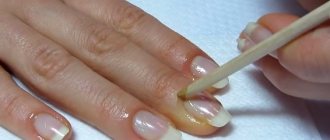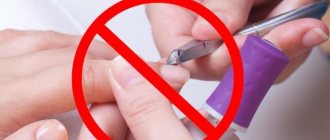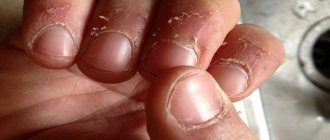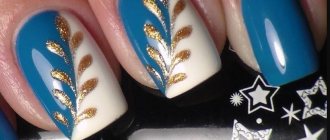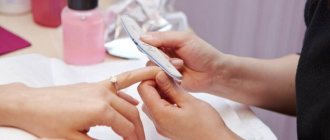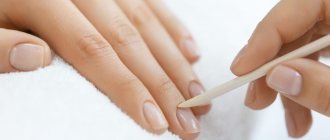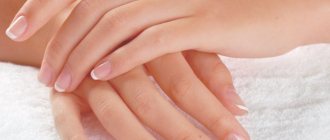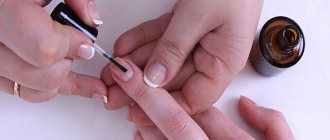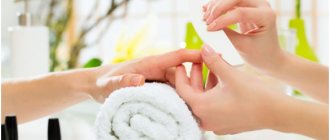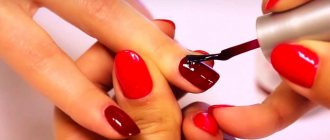- August 2, 2018
- Nail care
- Ksenia Stepanishcheva
In hardware manicure, each operation is performed using cutters. The nozzles have a specific relief designed for a specific purpose. Therefore, it is important to know which cutter to remove the cuticle? The answer to this question is presented in the article.
Hardware removal of cuticles is similar to the European version of manicure. During this procedure, dead skin is carefully removed, leaving the cuticle intact. This does not require pre-softening the skin. Processing is carried out dry. The essence of the procedure is that the overgrown skin is removed with a special cutter.
Required cutters
Which cutter should I use to remove cuticles? This depends on the purpose of the processing. Specialists use complex instruments that require skill and training. Home milling cutters are considered safe, and if the technology is followed, they can give excellent results.
A small set will be required. As you gain experience, you will be able to use a universal tool. Which cutter should be used to remove the cuticle if there are additional callous growths and it is necessary to treat cracks on the fingers? For this, a ball-shaped cutter is used. She delicately removes unevenness and rough areas without touching the nail. This cutter removes the stratum corneum from the cuticle.
Which cutter should I use to remove the cuticle if I also need to lift it? To do this, use a nozzle in the form of a cylindrical cone with a blunt end. It is also used for stripping nail plates to separate and remove pterygium.
Which cutter should be used to remove the cuticle and also process the nail sinuses? To do this, use a cylindrical nozzle with a narrow tip. It is also used to remove pterygium. This nozzle has 2 types - a sharp and a rounded tip.
Which cutter is better to remove cuticles in order to do the job as cleanly as possible? A nozzle with a sharp tip is ideal for this. But it is not advisable for beginners to use it. An attachment with a rounded tip is considered less traumatic and suitable for beginners who are mastering hardware manicure. The flat cylinder cutter removes dead skin from the side rolls.
How does a manicure machine work?
The device itself consists of a power supply and a micromotor handle, which contains attachments (cutters, caps, grinders, polishers).
The attachments are used for grinding, grinding and filing away nail plates, keratinized skin, calluses and corns. Hardware manicure, unlike edged manicure, allows you to remove the cuticle simply, painlessly and bloodlessly.
All modern models of milling cutters require a network to operate. If you wish, you can purchase a battery-powered device, but it will be low-power and not very reliable in operation. However, what kind of manicure machine to buy is up to everyone to decide for themselves.
Nozzle materials
Before determining which cutter to dry cuticles with, you need to consider the purpose of the treatment. The nozzles also differ in the material they are made of. They are divided into:
- Silicon and ceramic. These are the cheapest cutters. They are available in professional and home devices. The attachments have different abrasiveness and are suitable for working with rough finger surfaces and shaping nails. The products are also used to treat delicate areas.
- Diamond. Used for delicate treatment where a targeted effect is required, for example, in the area of the nail sinuses and pterygium. Such nozzles are among the most expensive, but they have a high degree of wear resistance. They are usually included with professional devices. In home devices, if there are such cutters, they have a rounded or beveled tip. This is due to security requirements.
- Silicone. They are used for grinding and polishing nails. They wear out quickly, but are also inexpensive.
Which cutter is used to lift the cuticle and remove pterygium from all of the above? Ceramic and diamond cutters are suitable for removing cuticles. The choice of nozzle depends on the hardness and thickness. Ceramic cutters are ideal for fleshy and rough cuticles.
For thin cuticles, it is better to use a fine-grained and diamond nozzle. In any situation, you need to have 2 options of cutters - ceramic or silicon to quickly eliminate keratinization. Diamonds perform excellent correction.
When you are just starting to learn hardware manicure, you should learn how to work with elementary cutters used in processing. Then you may need more complex attachments to perform various nail processing operations.
Rules for choosing a router for hardware manicure at home
First of all, you should pay attention to the power of the router: it should be 30 W or more. If you plan to use the device not only for manicure, but also for pedicure, you should take a closer look at more powerful devices (from 50 W).
Another important indicator is the rotation speed of the nozzle. It must be at least 30,000 rpm.
It’s not worth buying an expensive device. But it is better not to consider very cheap options, the quality, technical characteristics and durability of which are highly questionable.
A router with reverse would be an excellent choice. The main thing is that there is a collet mode on its handle - it will be much more convenient and comfortable to work with.
Auxiliary materials and tools
In order for a hardware manicure to live up to expectations, you need not only cutters and attachments. You will have to stock up on orange sticks, a product that softens and allows you to painlessly remove the cuticle, and an antiseptic. A brush for cleaning nail dust, a manicure extractor, and a file that allows you to correct the shape of the nail plate will come in handy.
Advantages
Removing the cuticle with a manicure machine is considered a safe procedure. It has the following advantages:
- Less time is wasted. If you have experience, all nails can be treated in half an hour. A classic edged manicure takes up to 1.5 hours.
- The device is safe, as injuries and infections are excluded. A cuticle cutter exfoliates dead skin cells, and a trimmed manicure also touches living areas, which causes small wounds, which is why infection appears.
- Hardware processing does not require preliminary preparation. In this case, there is no need to steam the skin, apply emollients or cuticle remover. Everything is done on dry skin.
- Hardware manicure is a delicate process; it is an excellent option for thin cuticles and for those who have blood vessels close to them.
- The machine allows you to treat rough areas of the skin. But edged and European manicures do this job with difficulty.
- The cuticle grows back more slowly after the procedure, and there is no risk of hangnails.
Thanks to these advantages, hardware manicure is considered popular. It gives you neat and beautiful nails.
Preparing for a hardware manicure
Before starting the procedure, it is necessary to disinfect not only all instruments and attachments, but also treat the nails and skin. All this can be done with special antiseptic solutions or regular medical alcohol. Thirty minutes before the start of treatment, wash your hands and feet with soap and dry thoroughly. Next, they begin to degrease the nails and remove the old varnish with a special liquid. Then they cover the cuticle with a softening composition and wait until it begins to act.
Flaws
Although hardware manicure has many advantages, there are also disadvantages:
- Due to inept use of the cutter, there is a risk of injury to the nails.
- Not exactly a clean result. Many people have voluminous cuticles, and for the aesthetic appearance of their hands, it is advisable to cut them off.
- Expensive device. Compared to trimmed and untrimmed manicure, to perform hardware cuticle removal you need to buy an expensive device, as well as milling attachments.
- Difficulty in maintaining equipment. Cutters must be regularly cleaned and disinfected, and if handled improperly, they can be damaged.
Rules of procedure
The work can be done not only in the salon, but also at home. How to properly remove cuticles with a cutter? Home appliance stores sell cuticle machines. Compared to professional ones, they have a small number of attachments and power. But lower power will be safer. It is important to purchase a device that has a speed of at least 2000 rpm. This will allow you to carry out the work cleanly. A minimum set of cutters will be enough, and if desired, you can purchase the necessary ones.
How to remove cuticles with a ball cutter? The procedure is performed according to the instructions:
- You need to lift and push the cuticle to the base of the nail bed. Then the keratinized layers of skin are removed from it using a milling cutter.
- Then the important work is performed - removal of the pterygium. Here you need to act delicately and carefully, since the work is carried out close to the nail. Pterygium should be removed carefully, moving the cutter almost parallel to the nail, without pressing on the plate.
- After cleaning the pterygium, the lateral ridges and sinuses can be treated. Grinding of burrs and microcracks is necessary.
- At the end, the fingertips are treated - keratinization and calluses around the nail and subungual part are eliminated.
If you follow these instructions, the processing will be safe and of high quality. Treated cuticles result in a beautiful manicure.
How to choose a machine?
The quality of your manicure will depend not only on your actions, but also on the right equipment. We would like to give you some small tips that will help you avoid making mistakes when purchasing.
- When choosing a device for home use, choose models with low power, making from 1500 to 5000 rpm. This is quite enough to remove cuticles, polish your nails and give them an ideal shape with minimal risk of damage. Such devices are small in size and very convenient for personal use.
- There is no need to chase after a large number of attachments. Practice shows that even masters usually use only the most necessary set.
- Give preference to trusted manufacturers. Such equipment will last you much longer and guarantees good results.
Cuticle removal using hardware manicure is a modern solution for those who take care of their nails. The information provided in this article is sufficient for choosing the right device and acquiring initial knowledge. We invite you to watch another step-by-step video that will introduce you a little closer to this technique.
Expert advice
While performing work, you must adhere to the following recommendations:
- The work must be done at a speed of at least 2000-5000 rpm. At this power, the keratinized layers are cleansed quickly and efficiently, and there are no unpleasant sensations. Professionals can work at a speed of 15,000-20,000 rpm.
- You should not stay in one place for more than 4 seconds; there is a risk of burns, as the nail plate heats up from friction.
- Do not press the cutter on the skin and nails, otherwise you may cause a wound.
- Each part of the processing uses its own cutter.
- When working with a cutter, you need to direct it in the opposite direction from its movement. With this technique, keratinization and dead skin cells are eliminated.
It is necessary to use different cutters to remove cuticles on the arms and legs. This is required according to hygiene rules - a lot of dirt and bacteria accumulate on the toes, which is dangerous due to infection on the fingers. In addition, the cuticle on the legs is coarser, and processing requires nozzles with greater abrasiveness, and for the hands, a fine-grained surface of the cutters is required. Rough abrasion damages the delicate areas of the fingers.
Sterilization
The cutters should be free of dirt, bacteria and infections. Sterilization of nozzles is carried out using disinfectant solutions:
- "Alaminol".
- "Optimax".
- "Gigasept."
- "Blanidas."
- "Korzolex".
These products are sold in concentrated form. For disinfection, you need to prepare a solution. The drug (3 tablespoons) is added to cold water (1 liter). When sterilizing attachments, it is necessary to take into account the hardness of the material and the depth of the notches.
Care
The soft covering deteriorates after prolonged disinfection, so it is necessary to reduce the time. The average duration is 30-40 minutes. After immersion in the solution, the nozzles must go through the remaining processing steps. Required:
- Cleaning under running water.
- Manual cleaning with a brass brush.
- Ultrasonic treatment.
- Immersion in dry heat or autoclave.
When performing a manicure, do not squeeze the handle too much or press on the nozzle. This causes the head to bend at the base of the handle, so the cutter will be unusable. The nozzle must be changed according to the instructions supplied with the device.
After sterilization, the cutters are placed in a cover that protects them from moisture, dust, and mechanical factors. The device must be adjusted and cleaned in a timely manner at a service center.
